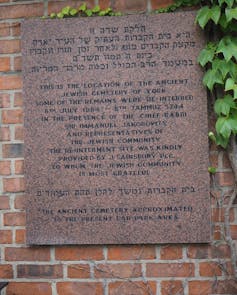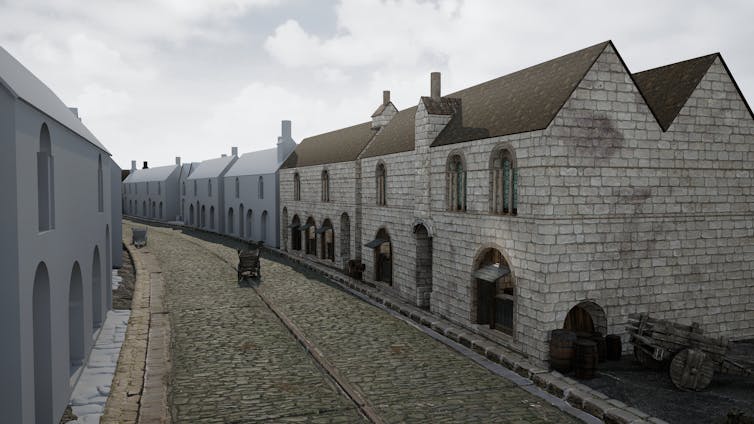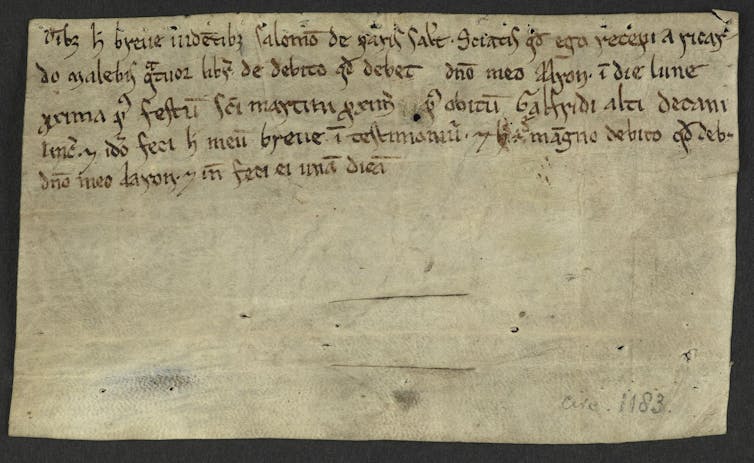On the last night of Hanukkah 2023, a service was held in York on the site of the 12th-13th century Jewbury cemetery. The event was led by Rabbi Elisheva Salamo, the first rabbi to live in York for over 700 years.
Prayers were said and 150 candles lit for the people known to have died in the pogrom at Clifford’s Tower in 1190. In the history of England’s Jewish communities, York is forever linked with this period of murderous antisemitism.
After attacks in London around the coronation of Richard I in 1189, the violence swept northwards. By March 1190, a mob instigated by Richard de Malbisse had laid siege to the castle in York, in which the local Jewish community had sought sanctuary. Those sheltering were told to choose between forced conversion or death. But when the few who did emerge to convert were immediately slaughtered, the remaining captives elected to commit mass suicide and the castle was set alight.
Historians have long examined how the Christian and Jewish communities co-existed in York both before and, crucially, after 1190. In the context of our ongoing research into the history of Coney Street – York’s thousand-year-old high street – we have found evidence of the significance of the Jewish community to the city’s civic life in the 13th century.
One figure in particular stands out: a French rabbi and noted scholar, Yom Tov (or Yom Tob) who moved to York from Joigny in France in the early 1180s, and whose writings are still widely used today.
York’s early Jewish community
The first references to a Jewish community in York date back to the 1170s. Property deeds held in York City Archives and Durham Cathedral Archives refer to two very substantial properties, occupied by two prominent Jewish figures, Josce and Benedict.
Historians have usually placed Josce’s house and synagogue on Coney Street, and Benedict’s house on Spen Lane. Our research has shown this oft-repeated assertion to be false, based on a misunderstanding of the charter evidence.
In fact, Benedict lived on a corner plot at the junction of modern Colliergate and St Saviourgate. Josce lived diagonally opposite, on the corner of Fossgate, probably around the site currently occupied by the Fossgate Tap and Blue Bell pubs.
Josce and Benedict’s community was established in York from Lincoln in the wake of a revolt against royal taxation in 1174, at the pleasure of the King Henry II (1170-1183). In keeping with the walled and gated seigneurial holdings in which Jewish communities lived in France and northern Spain, it is likely that Josce and Benedict both accommodated several families on both their sites.
Josce was wealthy and well connected, eager to ensure his community’s religious orthodoxy. At some point in the 1180s, he wrote to the Jewish community in Joigny, just south-east of Paris, asking for a scholar to be sent to York to teach the community. Yom Tov duly arrived.

A centre of Jewish scholarship and poetry
Research suggests York was a centre of Jewish scholarship and poetry. Yom Tov’s school and synagogue would most likely have been at Josce’s house on Fossgate, one of the only properties large enough to accommodate them. Josce himself was a noted scholar.
It is here that Yom Tov would have preached his sermons and debated the interpretation of the law with other learned men of the community. Yom Tov remains unique among medieval rabbinical scholars for two of his works still being used regularly, today.
Rabbi Eli Brackman, director of Chabad of Oxford and the Oxford University Chabad Society, has shown that both Askhenazi and Sephardic custom accept Yom Tov’s contribution to the Shulchan Aruch (the code of law). Specifically, Yom Tov said that it was acceptable to allow a gentile into a Jewish household on Chabbad (the Sabbath) for the purposes of the lighting a fire. It is tempting to think this was a pragmatic response, inspired by his experience of having lived through a winter in York.
Brackman also notes the significance of Tov’s contribution to the piyyutim or body of liturgical poems. One, titled Omnam Ken, is recited still today by Ashkenazi communities on the eve of Yom Kippur. As Rabbi Edward Feld notes, the poem is favoured for its insistence that only God can rescue humanity, through his forgiveness.

Historical chroniclers do not agree on whether Yom Tov lived permanently in York, as the city’s rabbi, or whether he was simply a frequent visitor. They do agree that he was involved in the events of 1190. According to the historian Barry Dobson, he called on his congregants to die at their own hands, by his side, in “the heroic tradition hallowed by Hebrew tradition”. This strongly suggests Yom Tov was, in fact, established in York.
Jews were absent from York for 600 years
The 12th-century English chronicler, William of Newburgh, describes Josce and Benedict’s “stone palaces” as “[attracting] the attention of their Christian neighbours”. In an antisemitic attempt at justification, he implies that their lavishness inspired envy and contributed to the “cause” of the pogrom.
Research shows that the massacre was, in fact, a way for the heavily indebted local gentry and citizenry to erase the evidence of their debts to the Jewish community, by burning the properties and the financial records and by killing the people to whom they were indebted.

Chroniclers put the number of victims between 50 and 500 people. Charter evidence suggests around 150 people died – likely, the entirety of the York community.
Following the expulsion of the Jews from England, by King Edward I, in 1290, there would be no Jewish presence in York for 600 years. In the 1870s, a small community fleeing the pogroms of eastern Europe arrived back in the city. One Jewish woman married a local Christian joiner and a small synagogue was established above the man’s workshop on Aldwark.
Census data shows this group never counted more than 120 congregants. They were led by rabbis from Leeds, home of a much larger community. But as numbers dwindled in the later 20th century, the synagogue finally closed in 1975 and the sacred scrolls returned to Leeds.
The return of a resident rabbi in York, in 2023, comes amid plans to build a new synagogue. A new chapter of English Judaism in York opens.
Louise Hampson works for The University of York. She receives funding from the AHRC and this work on which this articlke is based arose from a government-funded project.
John Jenkins does not work for, consult, own shares in or receive funding from any company or organisation that would benefit from this article, and has disclosed no relevant affiliations beyond their academic appointment.
This article was originally published on The Conversation. Read the original article.







